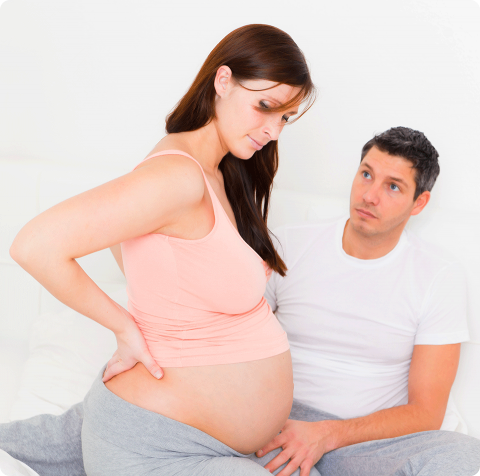Am I in labour?
Typically, a woman is given lots of notice that her body is going into labour. This is part of the protective design of the birth process. It means that she will have enough time to prepare the environment for birth. By this, we mean she will have time to reach the people she wants at the birth and to be in the place she plans to have her baby. Having the opportunity to prepare the environment for birth increases the safety of the experience for the woman and baby.
As a woman approaches the end of her pregnancy, she may start to experience physical and emotional signals that labour is not far off. These signs might include the baby descending into the pelvis (engaging); nesting behaviours (preparing the house); irregular contractions or tightenings; a 'show' (the cervical mucous plug coming away); and the waters breaking. Even with these signs occuring, there are normally many hours ahead before the baby arrives.
Engagement
During the final weeks of pregnancy, the baby's head moves down into the pelvis and 'engages', as the muscles of the uterus relax under the influenece of pregnancy hormones. You may experienced 'lightening' giving you more room to breathe. This can happen any time from 36 weeks, but in 50% first time mums, it happens between 38 and 42 weeks. For 80% of first-time mums, labour will begin within 2 weeks of the baby's head engaging.
For women having their second or subsequent baby, the baby might not engage until labour begins.
If the baby engages in the pelvic you can feel confident that the entrance to your pelvis is big enough and the probability is that the space inside your pelvis and the 'outlet' will also be big enough for your baby to pass through.
Nesting
During this time you might experience significant emotional changes as the hormonal balance of your pregnancy shifts. ‘Nesting’ is a definite phenomenon in late pregnancy, so don’t be surprised if an uncontrollable urge to clean or do baby laundry takes you in its grip.
Also accompanying this late pregnancy hormonal shift is an increase in your pain threshold from rising endorphin and a heightened apprehension about the baby’s wellbeing and the approaching birth. These anxieties tend to fade in the final weeks of pregnancy, and women often become quite fearless and confident about the adventure ahead.
Prelabour ‘Tightenings’
As labour approaches, the balance of oestrogen and progesterone changes and the natural level of prostaglandin increases. This increases the uterus’ sensitivity to oxytocin circulating in your blood and intensifies the uterine contractions which have been occurring since 30 weeks. Because oxytocin levels are highest at night after 37 weeks, these tightenings tend to happen when you are trying to sleep. Being able to catch up on sleep during the day in the final weeks is important. Research has shown that women who have had more sleep in late pregnancy have shorter labours.
The shift from the nocturnal pre-labour rhythm in contractions into early labour, varies from woman to woman and can be influenced by the level of mental activity you are engaged in day to day, your baby’s position and how ready you feel for labour.
Pre-labour or Braxton-Hicks contractions, will be softening and thinning your cervix and working to move your baby into a better position for birth. On the whole, they are not powerful enough to start to open up the cervix. The key difference between pre-labour or Braxton-Hicks and early labour contractions, is that pre-labour contractions do not change over time. They do not increase in length or get stronger or closer together. They might also be around 60 to 70 seconds in length, whereas early labour contractions will be shorter, at around 35-40 seconds long.
The Show
The show is often the first sign women have that labour is imminent or has started. It is the mucus plug which has been sealing the cervical canal during the pregnancy. It is often blood-stained and indicates that the cervix is softening and stretching.
Waters Breaking
Your waters might break before labour begins or at any time during labour. For about 6 – 19% of women, the waters break before labour begins and for 85% of women the waters will break spontaneously at the end of the first stage of labour, from 9 centimeters onwards.
Sometimes the water go with a gush and sometimes it’s just a trickle, it depends on how well applied the baby’s head is to your cervix. It is important to check the colour of the water on a maternity pad. If it has a yellow, green or black stain to it, this means that the baby has had a bowel movement in the amniotic fluid and you should call your midwife or doctor, they will probably want to check that you and the baby are ok. Ideally, the fluid will be a clear or pinkish colour.
Early Labour
Sometimes the contractions of pre-labour can feel business-like and you have to concentrate whist they stretch your cervix. When the baby’s position has altered sufficiently against the cervix that it begins to trigger greater oxytocin release, your contraction pattern will change and you will move into early or ‘latent’ labour. This is still not considered ‘real’ labour, though it can feel like it!
In early labour, something changes with your contraction pattern every 1-2 hours. The contractions get longer in length, they might get closer together or you might have to change what you are doing to work with them because they are becoming more intense. Now you are heading towards established labour, you’re going to have your baby!

